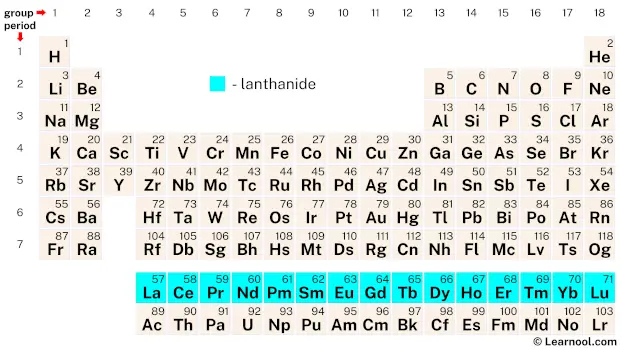
Lanthanides (also referred to as lanthanoids) are a series of 15 metallic elements that occupy the atomic numbers 57 to 71 in the periodic table. They are also referred to as the “rare-earth elements” due to their scarcity in the Earth’s crust. The lanthanides were first discovered in the mid-19th century, with lanthanum being one of the earlier lanthanides to be discovered by the Swedish chemist Carl Gustav Mosander in 1839. Mosander extracted a new rare-earth oxide from cerium nitrate, which he named “lanthanum” after the Greek word “lanthanein”, meaning “to lie hidden”, because the element was so difficult to separate from other rare-earth elements. Over the years, many other scientists worked to isolate and characterize the lanthanides, and in 1925, Victor Goldschmidt coined the term “lanthanide” to describe these elements.
Lanthanides are typically found in low concentrations in a variety of minerals, including monazite and bastnäsite, as well as in ion-adsorption clays in Southern China. The extraction and production of lanthanides is a complex process due to their similar chemical properties and the low concentration at which they are found in ores. As a result, the production of lanthanides is often associated with environmental concerns and challenges related to sustainability.
Lanthanides have unique physical and chemical properties, which make them useful in a wide range of applications. For example, the lanthanides are commonly used as catalysts in chemical reactions, as well as in the production of magnets, lasers, and lighting systems. Lanthanides also have applications in medical imaging, as well as in the production of electronic devices such as smartphones and TVs. Additionally, they are used in the production of superconductors and in the purification of petroleum.
Despite their many applications, the lanthanides remain relatively unknown to the general public. This is partly due to their scarcity and the difficulty involved in their extraction and production. However, the increasing demand for rare-earth metals in the production of advanced technologies and the growing concern over sustainability issues have brought the lanthanides into the spotlight in recent years.
On periodic table
| group | ⇨ | 1 | 2 | 3 | 4 | 5 | 6 | 7 | 8 | 9 | 10 | 11 | 12 | 13 | 14 | 15 | 16 | 17 | 18 |
| period | ⇩ | ||||||||||||||||||
| 1 | 1 H  Hydrogen |
2 He  Helium |
|||||||||||||||||
| 2 | 3 Li  Lithium |
4 Be  Beryllium |
5 B  Boron |
6 C  Carbon |
7 N  Nitrogen |
8 O  Oxygen |
9 F  Fluorine |
10 Ne  Neon |
|||||||||||
| 3 | 11 Na  Sodium |
12 Mg  Magnesium |
13 Al  Aluminium |
14 Si Silicon |
15 P  Phosphorus |
16 S  Sulfur |
17 Cl  Chlorine |
18 Ar  Argon |
|||||||||||
| 4 | 19 K  Potassium |
20 Ca  Calcium |
21 Sc  Scandium |
22 Ti  Titanium |
23 V  Vanadium |
24 Cr  Chromium |
25 Mn  Manganese |
26 Fe  Iron |
27 Co  Cobalt |
28 Ni  Nickel |
29 Cu  Copper |
30 Zn  Zinc |
31 Ga  Gallium |
32 Ge  Germanium |
33 As  Arsenic |
34 Se  Selenium |
35 Br  Bromine |
36 Kr  Krypton |
|
| 5 | 37 Rb  Rubidium |
38 Sr  Strontium |
39 Y  Yttrium |
40 Zr  Zirconium |
41 Nb  Niobium |
42 Mo  Molybdenum |
43 Tc  Technetium |
44 Ru  Ruthenium |
45 Rh  Rhodium |
46 Pd  Palladium |
47 Ag  Silver |
48 Cd  Cadmium |
49 In  Indium |
50 Sn  Tin |
51 Sb  Antimony |
52 Te  Tellurium |
53 I  Iodine |
54 Xe  Xenon |
|
| 6 | 55 Cs  Caesium |
56 Ba  Barium |
72 Hf  Hafnium |
73 Ta  Tantalum |
74 W  Tungsten |
75 Re  Rhenium |
76 Os  Osmium |
77 Ir  Iridium |
78 Pt  Platinum |
79 Au  Gold |
80 Hg  Mercury |
81 Tl  Thallium |
82 Pb  Lead |
83 Bi  Bismuth |
84 Po  Polonium |
85 At  Astatine |
86 Rn  Radon |
||
| 7 | 87 Fr  Francium |
88 Ra  Radium |
104 Rf  Rutherfordium |
105 Db  Dubnium |
106 Sg  Seaborgium |
107 Bh  Bohrium |
108 Hs  Hassium |
109 Mt  Meitnerium |
110 Ds  Darmstadtium |
111 Rg  Roentgenium |
112 Cn  Copernicium |
113 Nh  Nihonium |
114 Fl  Flerovium |
115 Mc  Moscovium |
116 Lv  Livermorium |
117 Ts  Tennessine |
118 Og  Oganesson |
||
| 57 La  Lanthanum |
58 Ce  Cerium |
59 Pr  Praseodymium |
60 Nd  Neodymium |
61 Pm  Promethium |
62 Sm  Samarium |
63 Eu  Europium |
64 Gd  Gadolinium |
65 Tb  Terbium |
66 Dy  Dysprosium |
67 Ho  Holmium |
68 Er  Erbium |
69 Tm  Thulium |
70 Yb  Ytterbium |
71 Lu  Lutetium |
|||||
| 89 Ac  Actinium |
90 Th  Thorium |
91 Pa  Protactinium |
92 U  Uranium |
93 Np  Neptunium |
94 Pu  Plutonium |
95 Am  Americium |
96 Cm  Curium |
97 Bk  Berkelium |
98 Cf  Californium |
99 Es  Einsteinium |
100 Fm  Fermium |
101 Md  Mendelevium |
102 No  Nobelium |
103 Lr  Lawrencium |
|||||
| – lanthanide |
Lanthanides are a group of 15 metallic elements found in the f-block of the periodic table, which includes lanthanum, cerium, praseodymium, neodymium, promethium, samarium, europium, gadolinium, terbium, dysprosium, holmium, erbium, thulium, ytterbium, and lutetium.
History

The discovery of lanthanides began in the late 18th century when a rare-earth mineral called cerite was discovered in Scandinavia. The mineral was named after the asteroid Ceres, which had been discovered at the same time. Chemists soon realized that cerite contained a new element, which they named ceria. They later discovered that ceria was actually a mixture of several oxides, including those of lanthanum and cerium.
Over the next century, chemists were able to isolate several other lanthanide elements from various rare-earth minerals. In 1839, Swedish chemist Carl Gustaf Mosander discovered two new elements, which he named lanthanum and didymium. Didymium was later found to be a mixture of two elements, praseodymium and neodymium, which were isolated in the 1880s. The remaining lanthanide elements were discovered over the next few decades, with the last, lutetium, being isolated in 1907.
While individual lanthanide elements were being discovered, chemists struggled to separate them from one another due to their similar properties. In the early 20th century, French chemist Georges Urbain developed a method for separating the rare-earth elements based on their atomic weights. This process, known as ion exchange chromatography, made it possible to isolate pure lanthanide elements and paved the way for their use in a variety of applications.
With the development of modern spectroscopic techniques in the 20th century, scientists were able to gain a better understanding of the electronic structure and chemical properties of the lanthanides. This led to the discovery of new lanthanide compounds and the development of new applications for these elements, including in lighting, electronics, and medicine.
Occurrence
Lanthanides are widely distributed in the Earth’s crust, but are relatively rare compared to other elements. They are primarily found in minerals such as bastnasite, monazite, and xenotime. Bastnasite, a mixed lanthanide-fluoride-carbonate mineral, is the primary source of light rare-earth elements such as cerium, lanthanum, and neodymium, while monazite, a phosphate mineral, is the primary source of heavy rare-earth elements such as europium, gadolinium, and terbium. Xenotime, a rare-earth phosphate mineral, is another significant source of lanthanides.
Production
The production of lanthanides involves a complex process that includes mining, beneficiation, and extraction. The ores are first mined and then processed to remove impurities. The processing methods depend on the type of ore and may include crushing, grinding, and flotation. After beneficiation, the ores are subjected to an extraction process that involves leaching with acids, solvents, or other chemicals to separate the individual lanthanides from each other and from other impurities.
In modern times, the demand for lanthanides has increased due to their use in a wide range of technologies, including electronics, magnets, and catalysis. Various modern methods have been developed for the production of lanthanides, including solvent extraction, ion exchange, and precipitation. Solvent extraction is the most commonly used method for separating and purifying lanthanides, while ion exchange is used for the separation of individual lanthanides.
China is the largest producer of lanthanides, accounting for over 80% of the world’s production. Other significant producers include the United States, Australia, and Russia. The global production of lanthanides is expected to continue to grow due to the increasing demand for these elements in high-tech industries.
Due to their increasing importance and rarity, efforts are being made to recycle lanthanides from end-of-life products. Recycling methods involve the recovery of lanthanides from discarded products such as electronic devices, fluorescent lamps, and rechargeable batteries.
Properties
Physical properties
Lanthanides are silvery-white, soft, and malleable metals that are highly reactive with water and air. They have high melting and boiling points, and their densities are higher than those of most other metals.
Chemical properties
Lanthanides are highly reactive metals that can form a wide variety of chemical compounds. They readily react with oxygen, water, and other elements to form oxides, hydroxides, and other compounds. Lanthanides also have a strong affinity for oxygen, and they can form alloys with many other metals.
Magnetism
Lanthanides exhibit strong paramagnetism, which means they are attracted to magnetic fields, and they have a high magnetic susceptibility. Some of the lanthanides, such as neodymium and samarium, are also ferromagnetic at low temperatures.
Optical properties
Lanthanides exhibit strong luminescence, meaning they emit light when exposed to certain wavelengths of light. This property makes them useful in a variety of applications, such as lighting, color displays, and laser technology.
Other properties
Lanthanides also have unique nuclear properties, including high neutron capture cross-sections and long-lived radioactive isotopes. They are also highly toxic and can pose a health hazard if not handled properly.
Applications
Catalysts
In the petroleum refining industry, lanthanide cerium is utilized as a catalyst to remove impurities and enhance the quality of fuels. Apart from this, neodymium is also used as a catalyst in the production of synthetic rubber.
Glass and ceramics
Lanthanides are added to glass and ceramics to impart unique optical properties. For example, europium is used to create red and blue colors in television screens, and terbium is used to create green colors. Lutetium and yttrium are used to make high-performance laser materials.
Lighting

Lanthanides such as europium and terbium are used in the production of phosphors for fluorescent lamps, television screens, and computer monitors.
Magnets
Lanthanides are used to make high-strength permanent magnets. Neodymium, praseodymium, and dysprosium are commonly used in the production of rare-earth magnets used in electric motors, generators, and hard disk drives.
Nuclear energy
Lanthanides such as gadolinium and samarium are used in nuclear reactors as control rods to regulate the rate of nuclear reactions.
Medical applications
Lanthanides are used in various medical applications, such as MRI contrast agents (gadolinium), radiation therapy (lutetium), and bone cancer treatment (samarium).
Battery technology
Lanthanides such as lanthanum, cerium, and neodymium are used in rechargeable batteries due to their high electrical conductivity.
Water treatment
Lanthanides are used in water treatment to remove impurities and heavy metals. Cerium, for example, is used in water filters to remove chlorine, lead, and other impurities.
Other applications
Lanthanides are used in a variety of other applications, including as pigments in paints and plastics, as additives in alloys, and as dopants in semiconductors.
Interesting facts
The name “lanthanide” comes from the Greek word “lanthanein,” which means “to lie hidden.”
The lanthanides are sometimes referred to as the rare-earth elements, although they are not particularly rare.
The lanthanides are very similar in their chemical properties, making them difficult to separate from each other.
Cerium was the first element to be discovered in the lanthanide series, in 1803.
The lanthanides are important in the production of hybrid cars, as they are used in the batteries and motors.
The lanthanides have unique magnetic and electrical properties, making them useful in electronic devices.
Lutetium is the heaviest and most expensive of the lanthanides, with a price of around $10,000 per kilogram.
The lanthanides are used in the production of steel and other alloys, as they improve strength and corrosion resistance.
Dysprosium is used in the production of neodymium-based magnets, which are used in wind turbines and electric vehicles.
The lanthanides are used in the production of catalytic converters, which reduce harmful emissions from automobiles.
Samarium has been used in the production of samarium-cobalt magnets, which are used in headphones, speakers, and other audio equipment.
The lanthanides have been used in the production of lasers, which have a wide range of applications, including in medicine and telecommunications.
Lanthanides have also been used in the production of glass and ceramics, as they can impart desirable properties such as color and transparency.
Related
More topics
- Block (periodic table)
- Group (periodic table)
- Period (periodic table)
- Metal
- Alkali metal
- Alkaline earth metal
- Lanthanide
- Actinide
- Transition metal
- Post-transition metal
- Metalloid
- Nonmetal
- Reactive nonmetal
- Noble gas
External links
- Lanthanide – Wikipedia
- Lanthanides: Properties and Reactions – Chemistry LibreTexts
- Lanthanide | Definition, Start, & Facts – Britannica
- Lanthanides and Actinides – CK-12
- Why are lanthanides and actinides so weird? – Quora
- Lanthanides – Properties of Element Groups – ThoughtCo
- The Periodic Table and the Lanthanides – De Gruyter Conversations
- Lanthanide Series – Encyclopedia.com
- The Parts of the Periodic Table – Angelo State University
- Chemistry for Kids: Elements – Lanthanides and Actinides – Ducksters
- The Chemistry of Lanthanides in Biology: Recent Discoveries, Emerging Principles, and Technological Applications – ACS Publications
- High School Chemistry/Lanthanides and Actinides – Wikibooks
- Lanthanide – an overview – ScienceDirect
- Lanthanides Facts (Lanthanoids) – Science Notes and Projects
- Lanthanides – University of California, Irvine
- Elements & Periodic Table: Lanthanide Series – Chem4Kids
- periodic table – Actinides and Lanthanides group – Chemistry Stack Exchange
- Lanthanides: Definition & Properties – Study.com
- The Lanthanides – TechnologyUK
- Lanthanides – Rare Earth Elements of the Periodic Table – ChemTalk
- List of Lanthanides and Actinides – Elements Wiki | Fandom
- The Lanthanides of the Expanded Periodic Table – Breaking Atom
- Lanthanides – Fisher Scientific
- Lanthanide – Chem Europe
- In what periods are the lanthanides and actinides? Where are they placed in the periodic table? – Socratic
- Everyday Uses of Lanthanides: The Rare Earth Elements – Revolutionized
- Lanthanides – Chemistry Learner
Deep
Learnool.com was founded by Deep Rana, who is a mechanical engineer by profession and a blogger by passion. He has a good conceptual knowledge on different educational topics and he provides the same on this website. He loves to learn something new everyday and believes that the best utilization of free time is developing a new skill.
